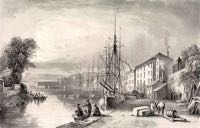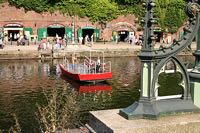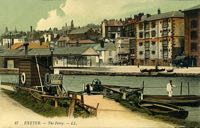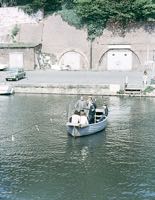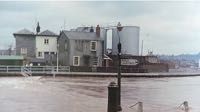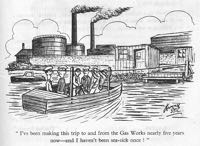
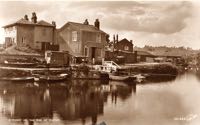 Butts Ferry
Butts Ferry
Page updated 3rd March 2018
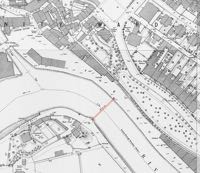 This
popular ferry that runs in the summer costs the princely sum of 20
pence (2004). It is human powered with the ferryman pulling the ferry
along a cable stretched across the river. When a large boat wants to
pass, the cable is lowered into the water. It saves a walk from the
quay to Shooting Marsh Stile and the Canal Basin over the Cricklepit
Suspension Bridge. The bridge was designed by Dave Hubbard and opened on
29th June, 1988. (4) On the Exeter side of the river is a range of small
businesses installed in the arches under the sandstone cliff.
This
popular ferry that runs in the summer costs the princely sum of 20
pence (2004). It is human powered with the ferryman pulling the ferry
along a cable stretched across the river. When a large boat wants to
pass, the cable is lowered into the water. It saves a walk from the
quay to Shooting Marsh Stile and the Canal Basin over the Cricklepit
Suspension Bridge. The bridge was designed by Dave Hubbard and opened on
29th June, 1988. (4) On the Exeter side of the river is a range of small
businesses installed in the arches under the sandstone cliff.
The earliest possible record of a ferry crossing the Exe appears in the "Letters and papers of John Shillingford, Mayor of Exeter 1447-50" published in 1871 by the Camden Society. Shillingford petitioned for funds to repair Exebridge. "Where of longe tyme and wythynne tyme of mynde was another brigge no way but by right a perillous fery bote; by which tyme were yn grete perill and meny perished and lost". It would appear that an accident had drowned many ferry passengers, which prompted Walter Gervaise to build the Exebridge in 1238 – this is considerably earlier than many of the established histories suggest.
A Royal Charter in1641 was granted to operate the ferry. In 1835 during the reign of William IV, the city applied for an Act of Parliament to build a bridge from Shilhay to Haven Banks and close the ferry, a plan that was not carried through.
Owned by the Council
The ferry was let by the council, normally for seven or twenty-one years. Records of early ferrymen are scarce, but it is known that there was a lease for the ferry between the quay and Shooting Stile Marsh, granted to Robert Newcombe, of Holy Trinity, in 1750 at a cost of £12 annually, for a period of five years. William Chard then took on a 21 year lease for the same sum. In 1769, one Benjamin Ash took the lease, also at £12 per annum. (5) Richard Sercombe, landlord of the Fountain Inn was the ferryman in 1803. Part of the Fountain Inn had served as the ferryman's cottage in earlier times. In 1822, John Mitchell was listed as a coal merchant and ferry man at the quay who also occupied the ferryman's cottage.
In August 1842 a to let by auction notice appeared in the Flying Post:
"Also for a Term of Seven Years, the EXETER FERRY, with the DWELLING HOUSE and APPURTENANCES, and the TOLLS of the said ferry." The winning bid at the September auction was to "Mr John Passmore of this city, mariner at £148 per annum."
By 1846 the lease was up for sale again, perhaps indicating that Mr Passmore had paid too much for the concession. The next ferry man was Mr Charles Edwards who ran it until April 1869 when he suddenly died, aged 72. Working the ferry was taken over by his wife Mrs S Edwards, who continued until her own death in June 1877, aged 83. The next December, their son, also Charles Edwards, who was landlord of the Port Royal public house, wrote to the Council offering to continue renting the ferry at the same rate as his late mother, at £100 per year. The Committee resolved to advertise the lease and in January 1878, it was offered for seven years from Lady-Day next, to George James Rendell Goodden (1). The indenture gave the rights of running the ferry along with a house and shed. In March 1885, the ferry was again offered for lease, which was taken by James Percy who last renewed in 1902. (5)
In January 1900 an article appeared in the Flying Post discussing a large cable 'punt' ferry that was being used in the Boer War. To explain to readers what it was like, it was likened to the cable ferry at the Quay, except a dozen times enlarged.
Grateful Swan
The Western Morning News published the story of an injured swan and the ferryman in December 1925. A swan which had flown into some telegraph wires was found half drowned, with a badly injured kneck, by the ferryman, Mr Bellinger. He rescued the bird, splinted its kneck, and fed it for two days, when it was released back into the wild, despite being advised to shoot it, as a kindness. He continued to feed it from the ferry. The swan recovered, but rather than return to its normal area of the river, it become attached to the ferryman. Each morning it went to the ferryman for 'breakfast', and when it did fly off to forage, would always return to the ferry in the evening. As a consequence, Mr Bellinger named it 'Pip'.
In the 1950s, the ferry was operated by a family called Pollard, who lived in the cottage by the ferry slipway, on the Haven Banks side of the river. Mr Pollard Senior kept a few racing pigeons in the ferry hut. (3)
In February 1953 the 9d weekly toll was abolished (it was a useful route to work at Haven Banks), although the 1d toll for people and bicycles remained. In November a new boat, costing £123 15s, was ordered from Messrs., Dixon & Sons of Exmouth as the old ferry's recent repairs were not satisfactory – the ferry was delivered in February 1954. (6)
The next ferry was built by Messrs., Holma & Son of Exmouth at a cost of £220 in 1960, while the ferryman's wage was increased to £4 10s plus the takings. By 1965 the ferryman's wage was increased to £7, while the toll was increased on the 1st January 1966 to 2d per person. (6)
The ferry is named
By the early 1970s, the ferry was losing money. In July 1972, the City Council, who had a statutory duty to run the service, tried to relinquish it. Mr George Butt, an insurance broker, fought to keep the service with a petition signed by 66 residents and 2,500 visitors – a seven hour public inquiry ruled that the ferry be retained. The Maritime Museum agreed to take over the running of the ferry. (4)
The Maritime Museum built a new ferry in 1978, and the ferryman, Mr Harry Andrews conveyed Prince Philip across the Exe for its first outing, when he visited the museum. Reg Lyon, also a ferryman, assisted with the crossing. By 1991, the ferry was transferred to the basin for exclusive use by the museum, and a new boat installed on the Exe crossing, this time run by Peter Hocking, who ran the well known Southern Comfort, which gave visitors trips to the Double Locks in the summer. (4)
Tragedy struck the ferry operation in September 1991, when Hocking's brother, 44 year old John, was killed when the Southern Comfort caught the wire crossing the river, causing the winch handle which tensioned the wire to swing violently, catching Mr Hocking on the head. The incident was witnessed by about 1,000 people, who watched the ambulance men battle to save his life, to no avail. (4)
On each side of the river at this point, is a lamp standard that was taken from the six that were located on the 1905 Exe bridge. They were cast by Macfarlanes of Glasgow. The lamp standards were removed from the old Exe Bridge in 1973, and these two painted in the city's official colours and installed on the quayside in 1983.
Sources: Flying Post and (3) Peter Hinchliffe and (1) Jacqueline Amos - (2) the Harry Still cartoon is copyright and used with permission, (4) Express and Echo. (5) List held by the Westcountry Studies Library. (6) Exeter City Council Navigation Committee minutes.
│ Top of Page │
